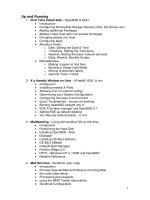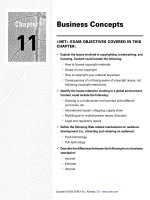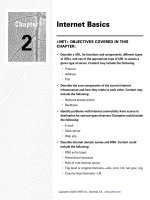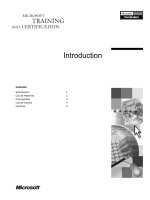Tài liệu Business Concepts pdf
Bạn đang xem bản rút gọn của tài liệu. Xem và tải ngay bản đầy đủ của tài liệu tại đây (725.9 KB, 36 trang )
Chapter
11
Business Concepts
i-NET+ EXAM OBJECTIVES COVERED IN THIS
CHAPTER:
Explain the issues involved in copyrighting, trademarking, and
licensing. Content could include the following:
How to license copyright materials
Scope of your copyright
How to copyright your material anywhere
Consequences of not being aware of copyright issues, not
following copyright restrictions
Identify the issues related to working in a global environment.
Content could include the following:
Working in a multivendor environment with different
currencies, etc.
International issues—shipping, supply chain
Multilingual or multicharacter issues (Unicode)
Legal and regulatory issues
Define the following Web-related mechanisms for audience
development (i.e., attracting and retaining an audience):
Push technology
Pull technology
Describe the differences between the following from a business
standpoint:
Intranet
Extranet
Internet
Copyright © 2000 SYBEX Inc., Alameda, CA. www.sybex.com
Define e-commerce terms and concepts. Content could include the following:
EDI
Business to business
Business to consumer
Internet commerce
Merchant systems
Online cataloging
Relationship management
Customer self-service
Internet marketing
Copyright © 2000 SYBEX Inc., Alameda, CA. www.sybex.com
T
he Internet started out as the province of government agencies
and academic institutions. Profit wasn’t an issue then. But as the Internet
extended its reach into households around the world, businesses realized the
potential for Internet commerce. Today, business facilitated by the Internet
is a giant industry. It continues to grow rapidly.
As an Internet professional, you have to understand the business issues
that (in many cases) drive technical innovations. From copyright, to market-
ing, to the design of Internet storefronts, you have to know what drives the
decisions. This chapter explains some of the issues.
Intellectual Property on the Network
I
ntellectual property
denotes any intangible product of a human being,
a group of human beings, or another legal entity (such as a corporation).
Intellectual property law aims to protect the rights of creative people to cap-
italize on the things they create.
Practically speaking, intellectual property is any creative product—partic-
ularly one that has monetary value. Examples of intellectual property
include the following:
The words to “Louie, Louie”
The text of
Hamlet
The cosmetic design of the iMac
The source code for the OS/2 operating system
Copyright © 2000 SYBEX Inc., Alameda, CA. www.sybex.com
514
Chapter 11
Business Concepts
The formula for making Coca-Cola
The Nike “swoosh” logo
The design of the Trinitron picture tube
The tune to “Macarena”
The question of what qualifies as intellectual property is an open ques-
tion—court cases come up all the time in which one party alleges that some-
thing previously unmentioned in law enjoys copyright protection. The
Harley-Davidson Motorcycle Company sued Honda over its bikes’ exhaust
noise. Harley claimed that its bikes’ noise was a distinctive feature of their
design and enjoyed copyright protection. Harley lost, but this case gives an
indication of the evolving nature of intellectual property law.
The computer revolution has forced many tests of intellectual property
protections, many of which came about in the days when making a copy of
a work of music or literature was a difficult, expensive process. Should a
piece of software, which may be duplicated perfectly, instantaneously, and
for negligible cost, enjoy copyright? Should Web publisher A be able to sue
Web publisher B when B “frames” A’s content and presents it as his own?
These are open questions still in the process of being decided.
Copyright
A
copyright
is the right of an author, artist, publisher, or other legal entity
to collect money from the use of words, music, performance works, items of
visual art, or other creative products. Facts and short phrases cannot be
copyrighted (though certain short phrases may be protected under trade-
mark law). Copyright, in the United States, attempts to guarantee the creator
several benefits:
The right to reproduce the work and distribute the copies
The right to revise and improve the work
The right to perform or display the work publicly
The right to have some assurance that the work won’t be defaced or
used in a way the author did not intend
The right to receive credit for others’ references to the work
Copyright © 2000 SYBEX Inc., Alameda, CA. www.sybex.com
Intellectual Property on the Network
515
A copyright depends on the ability of a person or entity that is claiming pro-
tection to prove original creation of the work in question and to prove that
creation took place on a certain date. U.S. law actually allows two creators
to have copyright on identical creative works, provided they arrived at their
respective creations independently of one another.
There’s a good copyright FAQ on the Web at
bricolage.bel-epa.com/
resources/lounge/bureau/copyright/
.
A creative work whose author renounces his copyright or refuses to
enforce it through infringement suits is said to be in the
public domain
. Pub-
lic domain works may be used by anyone, for any purpose, without the user
paying royalties or licensing fees to anyone. Other ways material may enter
the public domain include the following:
Copyright protection can lapse, as it does after some time period (usu-
ally 50 or 75 years after the author dies, depending upon when it was
first created or published).
Materials published by most governments (including that of the
United States and its individual state governments) are automatically
in the public domain.
Note that it is possible to sell public domain works. This is what the publishers
of William Shakespeare’s plays do, for example.
Getting a Copyright
On one level, it’s very easy to get a copyright. If you create a work, and can
prove the date on which it was created, you have a legal copyright. This is
known as a common law copyright. Common law copyright protects you
from the moment that you create a work. Of course, proving original cre-
ation and its date can be tricky.
If you put a copyright statement on a document, you alert the world that
you claim ownership of the intellectual property contained in that document.
A suitable copyright statement looks like this:
Copyright © January 1, 2000, Billy Pilgrim.
Copyright © 2000 SYBEX Inc., Alameda, CA. www.sybex.com
516
Chapter 11
Business Concepts
That copyright symbol is a tricky thing. The c-in-a-circle isn’t part of all
font packages, and it’s not clear that (c) is the legal equivalent of © just
because the former is easier to make with a computer. However, the spelled-
out word
copyright
should be adequate.
Because text can be edited so easily, you can improve the legitimacy of the
date from which you claim copyright protection by sealing your document in
an envelope and mailing it to yourself. The sealed, postmarked envelope
serves as stronger—but not absolute—proof that you had the intellectual
property on the date you claim.
Registered Copyright
You can achieve an extra level of legal protection for a creative work by reg-
istering the work with your government’s copyright office. Essentially, formal
copyright registration provides a fairly unquestionable way of establishing
when a work was created. The duration of copyright protection established
this way varies among media. To cite one example, an author who registered
a novel today would enjoy copyright protection for the remainder of her life,
and her heirs could enjoy the benefits of copyright protection for 50 years
after her death.
In the United States, the Copyright Office handles copyright registrations.
Its Web site appears in Figure 11.1. Other governments have similar agen-
cies. You request a registration form from the Copyright Office, fill it out,
and send it in to the government with two copies of the work you’re regis-
tering. You can request the necessary forms from the Copyright Office’s
voice-mail system at +1 202 707 9100 or get them on the Web in Adobe
Acrobat format at
www.loc.gov/copyright/forms/
. You need particular
forms for particular kinds of works. Here’s a list:
Form TX
Books, manuscripts, software, and games
Form PA
Music (in written form), plus films, video recordings, scripts,
and plays
Form SR
Music (recorded)
Form VA
Drawings, photos, and cartoons
Copyright © 2000 SYBEX Inc., Alameda, CA. www.sybex.com
Intellectual Property on the Network
517
Under a treaty called the Berne Convention, copyrights registered in any
signatory country are valid in all others. All major countries of the world are
signatories.
FIGURE 11.1
The U.S. Copyright Office Web site
Fair Use of Copyrighted Material
Copyright law recognizes that a vibrant creative community relies, in part,
on artists’ ability to use the creative products of others as starting points for
their own creative work. Such applications of copyrighted material are
known as
fair use
applications in the law.
Here are some examples of fair use:
Cited excerpts in academic work
Copyright © 2000 SYBEX Inc., Alameda, CA. www.sybex.com
518
Chapter 11
Business Concepts
Excerpts that appear in a review
Parody and satire
Reproductions for personal, not-for-profit use
These aren’t cast in stone—the nature of fair use is constantly undergoing
revision as those accused of copyright violations claim (and sometimes prove
to a court) that their use was fair.
Though no precise statement of what is not fair use exists, the determining
factors seem to be the size of the excerpt and the profit motive of the party
using the copyrighted material. Courts tend to favor fair-use claims pre-
sented by nonprofit organizations over those put forward by organizations
that have made money from their use of copyrighted material. If you’re not
making money (or causing the rightful copyright holder to lose money) as a
result of your use of brief snippets, you’re probably okay.
Licensing Copyrighted Products
If you want to use a copyrighted work in your own products—and remem-
ber, it does not matter whether the copyright is registered with a govern-
ment—you must ask permission. The copyright holder is free to do three
things:
Refuse you permission to use the material
Allow you to use the material free of charge, provided you credit the
copyright holder
Require you to pay a fee for the use of the copyrighted material
The last of the three options is called licensing, and it’s a big part of the
intellectual property business. Licensing deals take many forms and usually
state explicitly what rights are being granted and what compensation will be
paid for them. A writer, for example, might write a story and grant a mag-
azine the rights to publish the story once in its North American editions. The
magazine would pay a writer a fee for that right. The writer would retain the
rights to sell the story again for use as part of a compilation put out by a
book publisher, without consideration to the magazine. The writer would
also retain, for example, the ability to license the story to a movie studio for
adaptation into a screenplay.
Copyright © 2000 SYBEX Inc., Alameda, CA. www.sybex.com
Intellectual Property on the Network 519
Securing the Entire Copyright
If you’re a publisher and want to secure the copyright to a work created by
someone else (such as a freelance writer), you can secure the rights by either
of two means. A work-made-for-hire agreement states that the creator of a
work (the freelancer) created it because he was hired by the publisher to do
so and paid accordingly (or paid something, anyway). Therefore, the pub-
lisher has the copyright and the freelancer does not.
A creator also can transfer the copyright on a work to another entity by
assignment. Usually, assignment must involve an explicit, written statement
that says the original creator is granting her copyright to someone else, such
as a publisher.
Infringement Consequences
Copyright, in the United States and most developed countries, is a matter of
civil law. That is, a copyright holder cannot complain to the government that
someone has committed a crime by infringing upon her copyright. Rather, a
copyright holder can file a civil suit alleging infringement. If the civil suit
goes to trial and the infringement is found to have taken place, the defendant
may be made to pay damages to the copyright holder.
In point of fact, civil suits are expensive and generally are the last resort
of copyright holders who feel their rights have been infringed upon. Usually,
those using copyrighted material for purposes perceived to be unfair by the
copyright holders will receive stern letters from the copyright holder or his
lawyer, asking that the use stop. If the perceived problem continues, the
copyright holder can file suit and fight the matter in court. If an infringement
is determined to have occurred, the entity using the material without permis-
sion may be judged responsible for damages and made to pay money to the
copyright holder.
Trademarks
A trademark is much like a copyright except that trademarks apply to words,
phrases, and images used to describe products and services (technically, a
word, phrase, or logo that describes a service is called a servicemark, but the
legal concepts are pretty much the same). The following are examples of
trademark-protectable intellectual property:
A company’s name (e.g., Netscape Communications Corporation)
Copyright © 2000 SYBEX Inc., Alameda, CA. www.sybex.com
520 Chapter 11
Business Concepts
A product’s name (e.g., Diet Coke)
A logo (e.g., the AT&T globe image)
A graphic device (e.g., the Izod alligator)
Oppenheimer Wolff & Donnelly LLP, a law practice, has put together a neat
FAQ on the topic. It’s on the Web at www.owdlaw.com/intprop/trademark/
faq/faq.html.
Registering a Trademark
As is the case with larger creative works protected by copyright, U.S. law
provides for trademark protection on words, phrases, and devices even if
they’ve not been formally registered with the government. You can assert a
trademark or servicemark right by always printing a TM (for trademarks) or
SM (for servicemarks) next to the device you want to protect.
You can establish stronger legal protection for your trademark by regis-
tering it. Governments maintain registries of trademarked intellectual prop-
erty. In the United States, the U.S. Patent and Trademark Office (USPTO)
maintains the list of registered trademarks. To register a trademark, you
must establish that it represents a unique way of denoting a product or ser-
vice and is not in use by another entity. You must also be actively using the
trademark—you can’t register a trademark in anticipation of applying it to
a product or service you’ll develop in the future (though this used to be pos-
sible). Once you have registered a trademark, you can follow it with the ®
symbol to denote the registration.
You can get further information about registering a trademark at the USPTO
Web site, www.uspto.gov/.
Using Trademarked Material
Trademarks run the risk of bringing about their own demise. If a trademarked
word is heavily advertised and becomes synonymous with a product or ser-
vice, it loses its protectability. This is why Xerox Corporation is so adamant
that people not talk about “making xeroxes” or “xeroxing documents.” The
Copyright © 2000 SYBEX Inc., Alameda, CA. www.sybex.com
Intellectual Property on the Network 521
correct phrases, acknowledging the trademark on the Xerox name, are “mak-
ing Xerox copies” and “copying documents” (as with a Xerox copier). You
have to be careful to use trademarked words as adjectives, not nouns.
Generally, it’s not possible to license trademarked material. The compa-
nies holding the trademarks usually are loath to share them with those selling
products and services other than their own. There is protection, however, for
the incidental appearance of trademarks in creative media. The producers of
a movie that features a scene in Trafalgar Square—where a giant Virgin
Records sign appears—probably would not infringe upon Virgin’s trade-
mark protection by showing the sign in the film as an incidental part of the
scenery.
Infringement Consequences
Trademark protection is a matter of civil law, and so enforcement of trade-
mark rights is similar to that of copyrights. Refer to the copyright section for
information on legal enforcement of intellectual property.
Patents
Patent law exists to protect physical devices and processes. You might patent
a cleaner-running engine for automobiles, a faster kind of memory chip, a
way of making harder steel, or a chemical formula for a more flexible plastic.
Essentially, patent law is the same as the law governing other kinds of intel-
lectual property. The difference is in the nature of the creative product. In
applying for a patent, you agree to make the details of your product or pro-
cess available to the public in exchange for a monopoly in profiting from
your invention. The monopoly is limited by time—design patents (on the
appearance of a product) last 14 years in the United States, while the time
limit on utility patents (on products and processes) lasts 20 years.
David Kiewit, a patent lawyer, has posted a good patent FAQ on the Web at
patent-faq.com/index.htm.
Copyright © 2000 SYBEX Inc., Alameda, CA. www.sybex.com
522 Chapter 11
Business Concepts
Securing a Patent
Unlike other kinds of intellectual property, there are no implicit patents. You
can’t sue someone for patent infringement unless you have formally registered
your claim with your government’s patent office. Even if you and another
party arrived at the same product independently, the right to sue for patent
infringement goes to the party that first secures government registration.
In order to be protectable by patent, a product or process must satisfy the
following three requirements.
Useful The product or process must accomplish something desirable.
New It must not have been patented before.
Nonobvious The product or process must be the result of creative work,
not something that would come naturally to someone skilled in the trade
to which the product or process applies.
Of these, the newness and nonobviousness requirements are the hardest
to prove. Novelty can by verified by a search of existing patents, which is
something patent lawyers are trained to do. Expert witnesses can assert non-
obviousness.
In the United States, the U.S. Patent and Trademark Office (USPTO) han-
dles patent applications. Its Web site appears in Figure 11.2. You can apply
for a patent by describing it and filing the proper paperwork with the
USPTO. When the USPTO has examined your application and agrees that
your idea is patentable, you are granted a patent. Between the time you file
and the time you receive your patent, you can refer to your product as having
“patent pending” status. Legally, the phrase means little, but it may discour-
age aspiring idea thieves.
You can get further information about registering a patent at the USPTO Web
site, www.uspto.gov/.
Copyright © 2000 SYBEX Inc., Alameda, CA. www.sybex.com
Intellectual Property on the Network 523
FIGURE 11.2 The U.S. Patent and Trademark Office Web site
Licensing Patented Products
Companies and individuals that have secured patents on their inventions
often are eager to license their patents to others. Indeed, many companies
exist for the sole purpose of securing patents that may later be licensed to
production companies (this business model is common in the biotechnology
industries). Often, a patent license may involve a compensation system that’s
based on the number of products sold. At the end of each accounting period,
the licensee pays the patent holder some royalty for each instance of the pro-
tected item it sold during the period.
Copyright © 2000 SYBEX Inc., Alameda, CA. www.sybex.com
524 Chapter 11
Business Concepts
Open Source and Public Licensing
Most of the software industry is based on companies and individuals—soft-
ware publishers—writing software, compiling it, and selling the compiled
binary code to consumers. The publishers invest in the people and other
resources needed to create their products’ source code; they then keep that
source code secret. The idea is that a publisher deserves to profit from some-
thing in which it has invested money to produce.
But an alternative model has long been a part of the hobbyist and aca-
demic communities. These groups espouse the idea of writing software and
making the source code public, available for anyone to examine, modify, and
redistribute. Such freely distributed programs are called open source soft-
ware. The source code of certain Unix variants has always been available to
the public, and lots of Unix utilities are open source, too. But the idea hasn’t
started to translate into the world of Intel-standard processors until recently.
The Open Source Movement
The open source movement—an informal group of software publishers,
book publishers, academic institutions, and individuals—holds the belief
that software for which source code is freely available inspires innovation,
whereas closed source software stifles it. Opponents of the traditional micro-
computer business model and of Microsoft Corporation in particular, mem-
bers of the open source movement champions free software like the Linux
operating system, the Perl language, and the GNU utilities.
Public-domain software has no copyright protections at all. This means
that anyone may acquire, copy, and use the software without paying a licens-
ing fee to anyone (there’s no copyright holder to which to pay such a fee).
Publishers are free to charge for public-domain software, and they may get
the price they ask if they package it attractively and offer extra features, such
as technical support. This is the business model behind Red Hat, Caldera,
and other distributors of the Linux operating system, the kernel of which is
in the public domain.
The concept of copyleft is part of the open source movement. The idea of
copyleft is that an organization (usually a not-for-profit group like the Free
Software Foundation) establishes a copyright to an item of intellectual prop-
erty—source code for software, usually—then distributes it, free of charge.
People who use the software must agree to its licensing agreement, which
specifies they may not make a profit on its distribution. The GNU utilities
are covered by copyleft.
Copyright © 2000 SYBEX Inc., Alameda, CA. www.sybex.com









